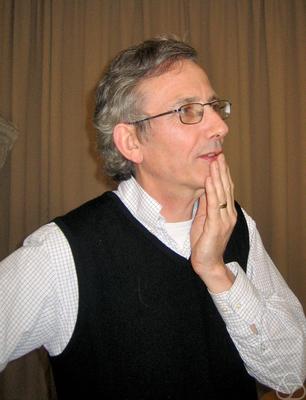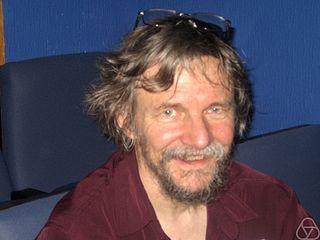
In algebraic geometry and differential geometry, a Calabi–Yau manifold, also known as a Calabi–Yau space, is a particular type of manifold which has properties, such as Ricci flatness, yielding applications in theoretical physics. Particularly in superstring theory, the extra dimensions of spacetime are sometimes conjectured to take the form of a 6-dimensional Calabi–Yau manifold, which led to the idea of mirror symmetry. Their name was coined by Candelas et al. (1985), after Eugenio Calabi who first conjectured that such surfaces might exist, and Shing-Tung Yau (1978) who proved the Calabi conjecture.

In mathematics, birational geometry is a field of algebraic geometry in which the goal is to determine when two algebraic varieties are isomorphic outside lower-dimensional subsets. This amounts to studying mappings that are given by rational functions rather than polynomials; the map may fail to be defined where the rational functions have poles.

Shigefumi Mori is a Japanese mathematician, known for his work in algebraic geometry, particularly in relation to the classification of three-folds.

Sir Simon Kirwan Donaldson is an English mathematician known for his work on the topology of smooth (differentiable) four-dimensional manifolds, Donaldson–Thomas theory, and his contributions to Kähler geometry. He is currently a permanent member of the Simons Center for Geometry and Physics at Stony Brook University in New York, and a Professor in Pure Mathematics at Imperial College London.
In mathematics, the pluricanonical ring of an algebraic variety V, or of a complex manifold, is the graded ring
In mathematics, Fujita's conjecture is a problem in the theories of algebraic geometry and complex manifolds, unsolved as of 2017. It is named after Takao Fujita, who formulated it in 1985.

David Eisenbud is an American mathematician. He is a professor of mathematics at the University of California, Berkeley and former director of the then Mathematical Sciences Research Institute (MSRI), now known as Simons Laufer Mathematical Sciences Institute (SLMath). He served as Director of MSRI from 1997 to 2007, and then again from 2013 to 2022.

Miles Anthony Reid FRS is a mathematician who works in algebraic geometry.
In differential geometry, a Kähler–Einstein metric on a complex manifold is a Riemannian metric that is both a Kähler metric and an Einstein metric. A manifold is said to be Kähler–Einstein if it admits a Kähler–Einstein metric. The most important special case of these are the Calabi–Yau manifolds, which are Kähler and Ricci-flat.

Alexander A. Beilinson is the David and Mary Winton Green University professor at the University of Chicago and works on mathematics. His research has spanned representation theory, algebraic geometry and mathematical physics. In 1999, Beilinson was awarded the Ostrowski Prize with Helmut Hofer. In 2017, he was elected to the National Academy of Sciences. In 2018, he received the Wolf Prize in Mathematics and in 2020 the Shaw Prize in Mathematics.
In algebraic geometry, flips and flops are codimension-2 surgery operations arising in the minimal model program, given by blowing up along a relative canonical ring. In dimension 3 flips are used to construct minimal models, and any two birationally equivalent minimal models are connected by a sequence of flops. It is conjectured that the same is true in higher dimensions.
In algebraic geometry, the minimal model program is part of the birational classification of algebraic varieties. Its goal is to construct a birational model of any complex projective variety which is as simple as possible. The subject has its origins in the classical birational geometry of surfaces studied by the Italian school, and is currently an active research area within algebraic geometry.
In algebraic geometry, a crepant resolution of a singularity is a resolution that does not affect the canonical class of the manifold. The term "crepant" was coined by Miles Reid (1983) by removing the prefix "dis" from the word "discrepant", to indicate that the resolutions have no discrepancy in the canonical class.
János Kollár is a Hungarian mathematician, specializing in algebraic geometry.
In mathematics, canonical singularities appear as singularities of the canonical model of a projective variety, and terminal singularities are special cases that appear as singularities of minimal models. They were introduced by Reid (1980). Terminal singularities are important in the minimal model program because smooth minimal models do not always exist, and thus one must allow certain singularities, namely the terminal singularities.
In algebraic geometry, standard monomial theory describes the sections of a line bundle over a generalized flag variety or Schubert variety of a reductive algebraic group by giving an explicit basis of elements called standard monomials. Many of the results have been extended to Kac–Moody algebras and their groups.
In differential geometry, algebraic geometry, and gauge theory, the Kobayashi–Hitchin correspondence relates stable vector bundles over a complex manifold to Einstein–Hermitian vector bundles. The correspondence is named after Shoshichi Kobayashi and Nigel Hitchin, who independently conjectured in the 1980s that the moduli spaces of stable vector bundles and Einstein–Hermitian vector bundles over a complex manifold were essentially the same.
In algebraic geometry, the abundance conjecture is a conjecture in birational geometry, more precisely in the minimal model program, stating that for every projective variety with Kawamata log terminal singularities over a field if the canonical bundle is nef, then is semi-ample.

Mark Lee Green is an American mathematician, who does research in commutative algebra, algebraic geometry, Hodge theory, differential geometry, and the theory of several complex variables. He is known for Green's Conjecture on syzygies of canonical curves.
Song Sun is a Chinese mathematician whose research concerns geometry and topology. A Sloan Research Fellow, he is a professor at the Department of Mathematics of the University of California, Berkeley, where he has been since 2018. In 2019, he was awarded the Oswald Veblen Prize in Geometry.







